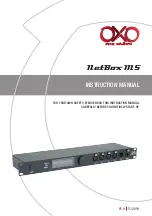
8-26
8
When using a receiver that has been installed separately into the ceiling, use the enclosed
fittings for installing to a ceiling.
Fig. 8-29
Fig. 8-30
Fig. 8-31
Part A
Part B
(1) Remove the metal plate of the receiver by slipping a slotted screwdriver or the like into the cutout on the bottom.
(2) Cut out a hole in the ceiling to match the dimensions of the enclosed template. (95 X 51 mm)
(3) Pass the wiring through the enclosed installation metal fitting and put it into the hole. (Fig. 8-29)
(4) Bend parts A and B of the metal fitting so they hold onto the ceiling firmly. (Fig. 8-30)
(5) Connect the receiver’s wiring (2 cores) with the wiring from the indoor unit. (Refer to the chapter on wiring the receiver)
When wiring receivers, be sure to double-check the terminal numbers of the indoor unit before connecting them so
there are no mistakes in the wiring. (Damage will occur if high voltage [e.g. supply voltage] is applied)
(6) Adjust the enclosed spacers so they are several millimeters thicker than the ceiling material and hold the receiver in place
temporarily with the 2 enclosed small screws. (M4 X 40)
(7) Bend parts A and B back so they fit in the opening and are in the gap between the surface of the ceiling and the receiver;
then tighten the screws. Do not use too much force when tightening the screws. Doing so may warp or damage the case.
Move the receiver by hand and check that it can move just a little. (Fig. 8-31)
(8) Attach the face plate.
3. Wiring the Receiver
If to be used as an embedded model ;
Use wiring of 0.5 mm
2
to 2 mm
2
for field supply.
Use a total wire length of no more than 400 m.
Polarity does not matter.
Wiring Diagram
Terminal strip for wiring the
remote control of the indoor
unit
Connections
Receiver wires
(field supply)
Wires from the
receiver unit
Receiver
Enclosed wire joints (2, white)
Receiver wires
(field supply)
Wire joint CE-1
(Enclosed)
Receiver wires
(field supply)
White
Black
1.
2.
3.
Strip the wire to be connected of its sheathing for 14 mm.
Twist the two wires together and crimp the enclosed wire joint.
If a special crimping tool is not used, or if the connection is made
using solder, wrap the joint with insulating tape.
Sec8.indd 26
2012/02/28 16:14:02
SM830211-07̲PAC-i.indb 26
SM830211-07̲PAC-i.indb 26
2013/09/17 23:03:37
2013/09/17 23:03:37
Summary of Contents for U-100PEY1E5
Page 536: ... MEMO 1 526 ...
Page 540: ... MEMO 2 4 ...
Page 549: ...3 9 3 3 1 Indoor Units Ducted Type S 36PN1E5 S 45PN1E5 S 50PN1E5 Electric Wiring Diagram ...
Page 551: ...3 11 3 3 2 Outdoor Units Single phase U 50PE1E5 ...
Page 552: ...3 12 3 3 2 Outdoor Units Single phase U 50PE1E5 ...
Page 553: ...3 13 3 3 2 Outdoor Units Single phase U 60PE1E5 U 71PE1E5 䡵 ...
Page 554: ...3 14 3 3 2 Outdoor Units Single phase U 100PE1E5 U 125PE1E5 U 140PE1E5 䡵 ...
Page 555: ...3 15 3 3 2 Outdoor Units Single phase U 60PEY1E5 U 71PEY1E5 ...
Page 556: ...3 16 3 3 2 Outdoor Units Single phase U 60PEY1E5 U 71PEY1E5 ...
Page 558: ...3 18 3 3 2 Outdoor Units 3 phase U 71PE1E8 ...
Page 559: ...3 19 3 3 2 Outdoor Units 3 phase U 100PEY1E8 U 125PEY1E8 ...
Page 560: ...3 20 3 3 2 Outdoor Units 3 phase U 100PE1E8 U 125PE1E8 U 140PE1E8 U 140PEY1E8 ...
Page 594: ...4 34 4 HIC PCB A746895 U 60PE1E5 U 71PE1E5 CN VDC U P V W N CN VDC 4WAY Valve CN 20S ...
Page 595: ...4 35 4 HIC PCB continued A746846 U 100PE1E5 CN VDC U V W CN VDC 4WAY Valve CN 20S P NU ...
Page 597: ...4 37 4 HIC PCB A746846 U 100PEY1E5 CN VDC U V W CN VDC 4WAY Valve CN 20S P NU ...
Page 598: ...4 38 4 HIC PCB continued A746847 U 125PEY1E5 CN VDC U V W CN VDC 4WAY Valve CN 20S P NU ...
Page 602: ...4 42 4 HIC PCB A747248 U 100PEY1E8 U 125PEY1E8 CN VDC U V W CN VDC 4WAY Valve CN 20S P NU ...
Page 738: ... MEMO 8 34 ...
Page 739: ...201309 ...










































